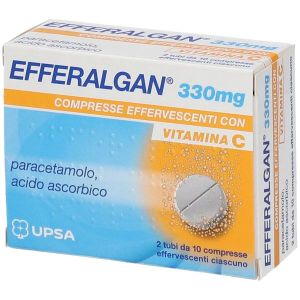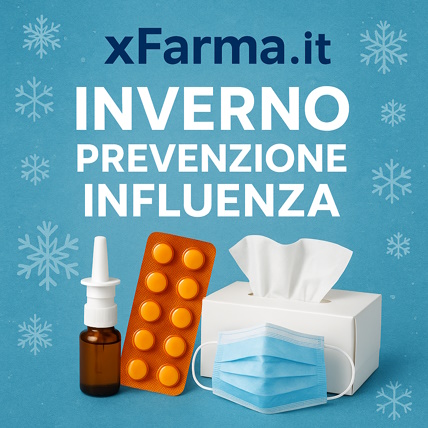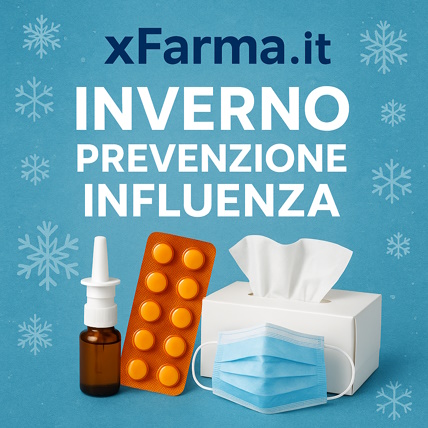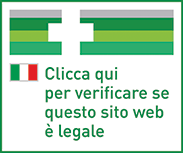Ship in Europe, Find out rates!
Efferalgan With Vitamin C 330mg+200mg 20 Effervescent Tablets

- box Delivery in Italy in 24/48 and free returns
- star3.000+ positive reviews
- dropboxOver 60,000 products in the catalog
Effervescent tablets with ascorbic acid and paracetamol .
Therapeutic indications
Efferalgan 330 mg effervescent tablets are indicated in the symptomatic treatment of mild to moderate pain and febrile conditions in adults and children. Symptomatic treatment of arthritic pain.
Dosage and posology
Completely dissolve the tablet in a glass of water and drink immediately. Due to the presence of vitamin C, avoid taking the medicine at the end of the day.
Efferalgan 330 mg effervescent tablets with vitamin C are reserved for adults and children weighing 26 kg or more (approximately 8 years or more). In children, dosage regimens based on body weight must be respected and therefore a suitable formulation must be chosen. The correspondence between age and weight is only indicative.
- Children weighing between 26 kg and 30 kg (aged between 8 and 10 years approximately): the dosage is 1 effervescent tablet for each administration, to be repeated, if necessary, after an interval of at least 6 hours, without exceeding 5 effervescent tablets per day.
- Children weighing between 31 kg and 40 kg (aged between 10 and 13 years approximately): the dosage is 1-2 effervescent tablets for each administration, to be repeated, if necessary, after an interval of at least 6 hours, without exceeding the 6 effervescent tablets per day.
- Adolescents weighing between 41 kg and 50 kg (aged between 12 and 15 years approximately): the dosage is 1-2 effervescent tablets for each administration, to be repeated, if necessary, after an interval of at least 6 hours, without exceeding 7 effervescent tablets per day.
- Adults and adolescents weighing more than 50 kg (about 15 years or more): the dosage is 1 or 2 effervescent tablets each administration, to be repeated, if necessary, after an interval of 4 hours, without exceeding 9 effervescent tablets per day.
An interval of at least 4 hours between administrations must always be respected. In children, the interval between administrations should be regular, both day and night, and should preferably be at least 6 hours. In adults and adolescents, an interval of at least 4 hours between administrations must always be respected.
In case of severe renal insufficiency (creatinine clearance less than 10 ml / min), the interval between dosing should be at least 8 hours.
Maximum recommended dosage: In adults and adolescents weighing more than 40 kg, the total dosage of paracetamol should not exceed 3 g / day.
Overdose
There is a risk of intoxication, especially in patients with liver disease, in chronic alcoholism, in patients with chronic malnutrition, and in patients receiving enzyme inducers. In these cases, overdose can be fatal. Symptoms usually appear within the first 24 hours and include: nausea, vomiting, anorexia, paleness, malaise and diaphoresis. Overdose with acute ingestion of 7.5 g or more of paracetamol in adults and 140 mg / kg body weight in children causes hepatic cytolysis which can progress to complete and irreversible necrosis, resulting in hepatocellular failure, metabolic acidosis and encephalopathy, which can lead to coma and death. At the same time, increased levels of hepatic transaminases (AST, ALT), lactic dehydrogenase and bilirubin are observed, together with a decrease in the prothrombin value, which may occur 12 to 48 hours after administration. Clinical symptoms of liver damage usually manifest themselves after a day or two, and peak after 3-4 days.
Contraindications
Hypersensitivity to paracetamol or propacetamol hydrochloride (precursor of paracetamol) or to any of the excipients.
Side effects
Skin reactions of various types and severities have been reported with the use of paracetamol including cases of erythema multiforme, Stevens-Johnson syndrome and epidermal necrolysis. Hypersensitivity reactions such as angioedema, edema of the larynx, anaphylactic shock have been reported. In addition, the following undesirable effects have been reported: thrombocytopenia, leukopenia, anemia, agranulocytosis, liver function abnormalities and hepatitis, kidney disorders (acute renal failure, interstitial nephritis, haematuria, anuria), gastrointestinal reactions and dizziness. The table below lists the adverse reactions, some of which have already been mentioned above, associated with the administration of paracetamol, resulting from post-marketing surveillance. The frequency of adverse reactions listed below is not known.
Pregnancy and breastfeeding
Clinical experience with the use of paracetamol during pregnancy and lactation is limited.
- Pregnancy
Epidemiological data on the use of therapeutic doses of oral paracetamol indicate that no undesirable effects occur in pregnant women or on the health of the fetus or neonates. Reproductive studies with paracetamol did not reveal any malformation or foetotoxic effects. However, paracetamol should only be used during pregnancy after a careful evaluation of the risk / benefit ratio. In pregnant patients, the recommended posology and duration of treatment should be strictly observed.
- Feeding time
Paracetamol is excreted in small quantities in breast milk. Rash has been reported in breastfed infants. However, administration of paracetamol is considered compatible with breastfeeding. However, caution should be exercised in administering paracetamol to breastfeeding women.
Special warnings
Paracetamol should be administered with caution to patients with mild to moderate hepatic insufficiency (including Gilbert's syndrome), severe hepatic insufficiency (ChildPugh> 9), acute hepatitis, concomitant treatment with drugs that impair liver function, glucose deficiency -6-phosphate dehydrogenase, haemolytic anemia. Do not administer during chronic treatment with drugs that can determine the induction of hepatic monooxygenases or in case of exposure to substances that can have this effect.
Paracetamol should be administered with caution in subjects with renal insufficiency (creatinine clearance ≤ 30 ml / min). Use with caution in case of chronic alcoholism, excessive alcohol intake (3 or more alcoholic drinks per day), anorexia, bulimia or cachexia, chronic malnutrition (low reserves of hepatic glutathione), dehydration, hypovolemia. During treatment with paracetamol, before taking any other drug, check that it does not contain the same active ingredient, as serious adverse reactions can occur if paracetamol is taken in high doses. Instruct the patient to contact the physician before associating any other medication.
High or prolonged doses of the product can cause high-risk liver disease and alterations, even serious ones, in the kidney and blood. In case of prolonged use it is advisable to monitor liver and kidney function and blood count. In case of allergic reactions the administration should be suspended. Avoid administration to children under the age of 8, unless otherwise advised by the doctor.
Expiry and retention
Check the expiration date indicated on the package. The expiry date indicated on the package refers to the product in intact packaging, correctly stored.
Warning : do not use the medicine after the expiry date indicated on the package.
Composition
Each tablet of Efferalgan 330 mg effervescent tablets contains:
Active principle
Paracetamol 330 mg, ascorbic acid 200 mg.
Excipients
Sodium bicarbonate, potassium bicarbonate, sorbitol, citric acid, sodium benzoate, docusate sodium, povidone.
| Destination | Cost | Detail |
|---|---|---|
| Italy | €5,90* | 24/72H |
| Austria, France, Germany, Slovenia | € 13* | 3 days |
| Belgium, Luxembourg, Portugal, Netherlands, Spain | € 14* | 4 days |
| Bulgary, Cechia, Hungary, Poland, Romania, Slovakia | € 19* | 5 days |
| Denmark, Estonia, Finland, Ireland, Lithuania, Latvia ,Sweden | € 22* | 5 days |
| United Kingdom, Switzerland, Greece, Malta/td> | € 30* | 7 days |
| Canada | € 40 | 7 Days |
European shipments with express courier: FedEx, MBE, DHL
*For the shipment outside band B ther's an extra cost of 22€ *For the shipment outside band C ther's an extra cost of 30€ Delivery Times exclude Saturday and Holidays
For Islands and Areas of difficult Accessibility the shipments are made in 72 hours and the cost will be increased by 15€


